



Featured image: “Binoculars” at CHB in Berlin (2013)
Varvara Guljajeva & Mar Canet have been working together as an artist duo since 2009. They have exhibited their art pieces in a number of international shows and festivals. As an artist duo they locate thermselves in the fields of art and technology, and are interested in new forms of art and innovation, which includes the application of knitting digital fabrication. They use and challenge technology in order to explore novel concepts in art and design. Hence, research is an integral part of their creative practice. In addition to kinetic and interactive installations, the artists have also experience with working in public spaces and with urban media.
Varvara is originally from Estonia, and gained her bachelor degree in IT from Estonian IT College, and a masters degree in digital media from ISNM in Germany and currently is a PhD candidate at the Estonian Art Academy in the department of Art and Design. Mar (born in Barcelona) has two degrees: in art and design from ESDI in Barcelona and in computer game development from University Central Lancashire in UK. He is also a co-founder of Derivart and Lummo.
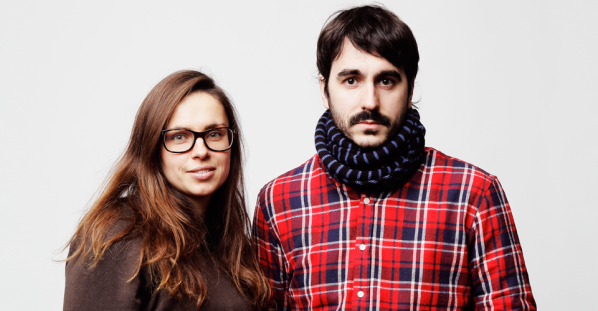
Filippo Lorenzin: Open culture is one of the main points of your research and activity. Could you describe how this influences your art practice?
Varvara & Mar: We are living in very exciting times. Open source has introduced democratization of production and creation. Now you can build your own 3D printer, laser cutter, knitting machine, make a light dimmer circuit or develop a body tracking system. Some years ago we couldn’t even imagine this and now we have access to this knowledge. People share their creations and these process, which is incredibly inspiring for us and many more people. Thus, knowledge is built on top of knowledge. We make use of open source marterial in our work and we try also to contribute back. This is the whole point of open source in our mind. And if one looks in the perspective of art to open source projects, then really many open source projects have artists on board, for example, OpenFrameworks, Processing, and more.
Open source also has an educational aspec. We do many workshops with people and teach what we know and how we work. We think open source culture is largely based on the spirit being open to sharing knowledge with many others.
FL: I’m really fascinated by your interest in textile fabrication. it reminds me the early industrial developments that were deeply connected to in the textiles industry. How and why would knitting be integrated these days as part of a makers’ culture?

V&M: The process of integration is well under way. There has been a good number of makerspaces who have dedicated areas for textile production, like WeMake in Milan and STPLN in Malmö. And believe it or not this simple thing helps to introduce gender balance in these kind of places. We’re not just talking about innovation, which can boost gender equality when you introduce knitting to hacking. We’re also talking about the democratisation of production, when thinking about clothing too. This area is quite vital and commonly understood. 3D printing toys is a cool activity for a weekend, but then it becomes boring. Knitting a sweater or a scarf has real value and the quality is always higher than a typical mass produced factory product.
For 3D printing we cannot say the same. Don’t get us wrong, we are not against the 3D printing. We love it and have six printers in our studio. Our point is that the areas of concern for digital fabrication are not complete, and the founders of FabLab have overlooked the whole area of textiles.
FL: You’ve run many workshops taking in account various topics such as 3D printing, solar energy and knitting, of course. How do these activities connect with your research?
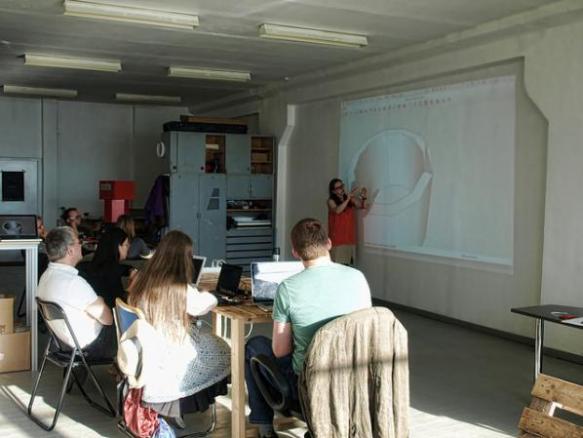
V&M: First of all, we like to teach and interact with our students. Second, preparing a workshop, allows us to research more about the field, and organise and share our accumulated knowledge and experience.
And finally, workshops are one part of our income. We don’t have any other jobs on the side, and exhibitions and commissions are not regular and do not always pay well, and yet the bills keep coming in. Hence, workshops help us to pay our bills.
FL: One of your works which most fascinate me is “Sonima” (2010). It’s a project that takes in account questions that have become quite recurrent in last months, mostly linked to Anthropocene discussions. The soft coexistence of technology and nature which is organic and artifical. Which is one of the main topics of your research: why are you so interested in this question? It looks like you’re trying to develop experiments for an utopistic future in which humans and nature live in symbiosis. Am I wrong?
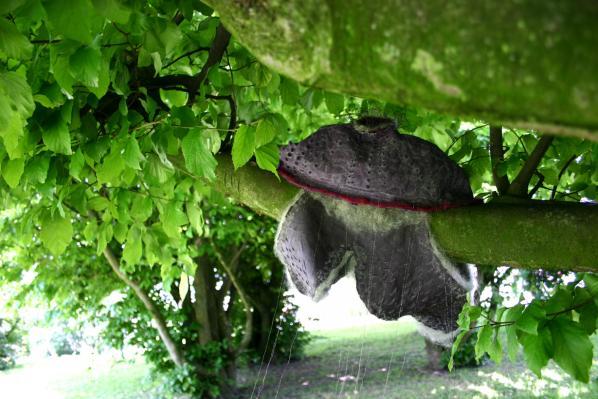
V&M: Yes, many of our works express our futuristic thoughts or imagination where the digital age will lead us and our planet to. It is nice that you have noticed this. I would say this kind of concept in 2010 was quite subconscious. I (Varvara) was very interested in organic form but with mutational origins but still adapted by nature.
More conscious approach towards anthropocene epoch can be seen and felt in “Tree of Hands” (2015), which is one of our recent works. However, it looks like we have touched quite a taboo topic. For instance, “Tree of Hands” was rejected by jury of PAD London fair because of its depressive concept.
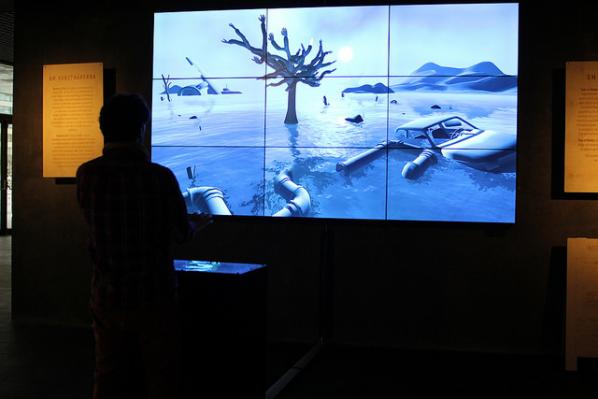
FL: “Shopping in 1 Minute” (2011) is another project I would like to ask you about. This work is about consumerism at its finest (or worst), turning one of the most typical capitalistic places (supermarkets) into ludic spaces. It’s a piece of social art that presents itself without informing the public what is right and what is wrong, but it rather suggests in a more subtle way the perversion at the base of that system. What do you think?
V&M: Yes. What we are doing is the absurd exaggeration of the same action (buying) to a maximum with one but: not buying and playing instead. There is a saying that shopping is 5 min happiness. The artwork tries to create a synthetic feeling of satisfaction of the ability to buy. The shopping centers are doing everything to stimulate our consumption needs, and our artwork manages to get inside their ecosystem and playfully releases that artificial desire to buy.
FL: With at least a couple of projects, you’ve also worked to the redefine hurban landscapes by looking at the invisble while at the same time taking on rather specific forces such as mass use of Wi-Fi networks becoming part of the everyday. I can’t help thinking that this is somehow related to privacy questions, probably because one of the most notorious scandals some years ago was Google’s secret recording of Wi-Fi networks with their Street View cars. Am I wrong?
V&M: Not really. But definitely Google has played a role in feeing our concerns about being watched, spied, hacked, scanned, etc. For example, the last scan for WiFi router names we did last summer in Tallinn some people were quite freaked out seeing a person on a bike with a camera on its head and tablet in front. I was even once asked if I worked for Google. 🙂 Anyways, the project was great fun for us, and we got to explore the city and discover the whole invisible communications networks and the self expressive layers of it all. After the Tallinn scan we even changed our minds about the 32-character local Twitter that the WiFi router SSID could be used for. The Tallinn experience showed us the new tendency: where people would use radio waves for semi-anonymous graffiti, communicating sometimes silly, protective, racist or political messages.
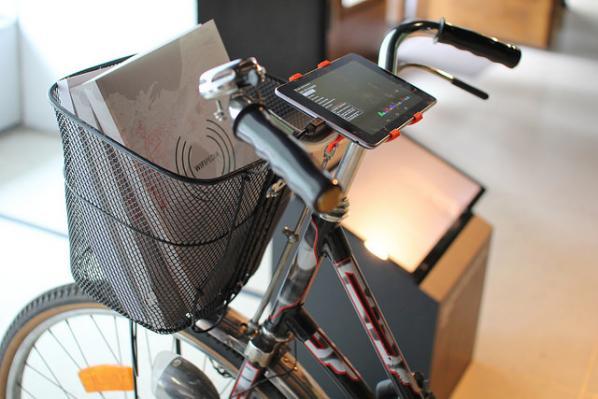
Talking about inspiration for this project, we got our interest for WiFi names from one article talking about the ability to track down pro- and contra-Obama communities by just looking at WiFi names in the neighborhood. This was before the US president election. Then we started to thinking of an art project on this topic.
FL: “The Rythm of City” (2011) is another project which is also ‘subtly’ related to control issues. The idea that someone can depict the state of a city by looking at data deducted from social media and web platforms. This type of thing is real now isn’t it – what do you think?

V&M: Definitely it is. However, the work’s main intention is not to talk about control issues rather about big data and its applications. Perhaps the main intention of this work is to offer to the viewer(s) a birds eye view on different cities in real time. In other words, The Rhythm of City allows you to zoom out and witness the larger picture on the current situation. And this larger picture is formed by everybody’s activity on social media, which is tracked down every minute. We call this action ‘unaware participation’ by digital inhabitants. The urban studies of Bornstein & Bornstein from early 1970s served as an inspiration for this artwork. They had discovered a positive correlation between the walking speed of pedestrians and the size of a city. Simply put: the bigger a city, the faster people move. The artwork demonstrates our interpretation of a city’s tempo through in its digital form or life. Hence, The artwork talks about pace of life in different cities at the same moment when the piece is viewed.
FL: What have you been working on these last few months and what plans do you have for 2016?
V&M: We are working on a series of new works talking about money. When we have completed “Wishing Wall” in London in 2014, since then we have noticed that the majority of people, especially a younger audience, wish for money. This really caught our attention. The ongoing hard economical situation in Europe pushes forward the need for money and also introduces a growing gap between the economical classes. So we’re investigating people’s desire for money and its connection with happiness. Making use of interactive technology we are aiming to approach playfully and magically the desire for becoming rich. At the same time, we cannot let go of knitting. At present, we are working on an open source flat knitting machine, which will be able to knit patterns also. Besides the new productions, we are showing our existing works in various exhibitions. For the confirmed ones, “The Rhythm of City” will be part of “REAL-TIME” a group show curated by Pau Waelder in Santa Monica museum in Barcelona from the 28th January. In February “Digital Revolution” (the touring exhibition by Barbican), which “Wishing Wall” is part of, moves from Onassis Cultural Center in Athens to Zorlu Center in Istanbul. And hopefully we get couple of other shows and new productions that are in the air at the moment and still to be confirmed soon.
Die GstettenSaga: The Rise of Echsenfriedl review. SPOILER WARNING!
Johannes Grenzfurthner’s Post-Apocalyptic DIY Epic on Makers, Hacktivism and Media Culture.
“A mad post-collapse satire of information culture and tech fetishism, in a weird sort of melding of Stalker, Network, and The Bed-Sitting Room.” (Richard Kadrey)
Die GstettenSaga: The Rise of Echsenfriedl is an Austrian hackploitation art house film by Johannes Grenzfurthner, mastermind of the international art-technology-philosophy group monochrom, co-produced by the media collective Traum & Wahnsinn. Reimagining the makerspace as grindhouse, the story is set in the post-apocalyptic aftermath of the “Google Wars” – an armed global conflict between the last two remaining superpowers China and Google – which has turned what remained of the Alps into a Gstetten.
In Austrian German, “Gstetten” translates to wasteland, outback or ‘fourth world’ (Manuel Castells) and is a popular name for provincial towns – and sometimes just the less sophisticated parts of them. The area’s biggest semi-urban sprawl is Mega City Schwechat, the former home of Vienna International Airport, a refinery and a beer brewery. It is governed by the evil media mogul Thurnher von Pjölk (Martin Auer), a pretender who claims to be the inventor of key publishing technologies such as letterpress printing and rules the area with his tabloid newspaper. But the hegemony of his yellow press empire is contested by – spoiler alert! – makers, hackers and nerds, who are more leaning towards electronic media such as the recently rediscovered television. In order to get rid off this bothersome opposition, Pjölk devises an evil plan for wiping out Schwechat’s insubordinate creative class.

In an insidious political move, he pretends to reach out for the technophile faction by commissioning two of his reporters, the bootlicking opportunist Fratt Aigner (Lukas Tagwerker) and the brainy geek girl Alalia Grundschober (Sophia Grabner), to conduct an exclusive TV interview with the ultimate Gstetterati icon, the legendary innovator Echsenfriedl (“Lizard Freddy”) – on the basis of precarious employment conditions. The title character, who turns out to be an basilisk, embodies a mix of Steve Jobs, Richard Stallman and Julian Assange and lives in the depths of Niederpröll in his hideout much like Subcomandante Marcos – partly in order to protect the world from his killing gaze, which would, audio-visually transmitted, turn the whole of his fan base immediately to stone.
Grenzfurthner’s sci-fi-horror adaption of the Divine Comedy takes us on a retro-futuristic post-cyberpunk adventure in the tradition of cinema grotesque back to the dark days which preceded the Internet. The journey of our heroes – distinctively resembling Tarkovsky’s ‘stalkers’ – is a quest for extinct media technologies but their search for Echsenfriedl eventually leads the two protagonists to a deepened understanding of who they really are: the media industry’s precarious workforce under spectacular capitalism. While Fratt’s dirt track to enlightenment is paved with stumbling blocks, his brainy Beatrice advances with the determination of a Harawayian cyborg who makes use of her superior technical skills to save them from the zombified folk populating the Gstetten: uncanny creatures from the Kafkaesque bestiarium of Austria’s undead bureaucracy and its hanger-ons like armed-to-the-teeth Postal Service subcontractors (brilliant: monochrom’s Evelyn Fürlinger, also Grenzfurthner’s ex-wife) or the once powerful Farmers Association led by Jeff Ricketts (Firefly, Buffy the Vampire Slayer), who are worshipping antique pre-war EU funding applications as their sacred scriptures. Our friends receive the final hints for their search from the Sphinx Philine-Codec Comtesse de Cybersdorf (Eva-Christina Binder), a fantasy femme fatale who is torn between Plöjlk and Echsenfriedl, and the bearded drag queen Heinz Rand of Raiká (David Dempsey), an eccentric agricultural cooperative banker and possible descendant of Conchita Wurst.

The Gstettensaga’s fascinating cinematic pastiche is more than just a firework of rhizomatic intertextuality, a symptom of the depthlessness of postmodern aesthetics or excessive enthusiasm for experimentation in the field of form. In their infamous 1972 book Anti-Oedipus, Gilles Deleuze and Félix Guattari have identified the technique of bricolage as the characteristic mode of production under “schizophrenic” capitalism, a facet triumphantly magnified by the filmmakers. If every discourse is bricoleur, like Jacques Derrida suggested, suddenly ‘context’ can become the artist’s material or even a form of art in its own right:
“The more artists are consigned to an existence within a patchwork of niches, the more dependent they become on information resources, communication and networking. In this respect, aesthetic artefacts must take a stance toward a plethora or markedly heterogeneous contexts that sediment in one way or another: the conditions and circumstances surrounding their production, their various social fields from which (and for or against which) they speak: real or imagined audiences toward (or against) whose values a work, an approach or a position is targeted. This play with the factors affecting it and among which it must mediate has become an essential trait on an art form that might best be described as ‘Contextualism’.” [1]

What I found especially intriguing about the Gstettensaga is how the filmmakers responded to the various challenges of the feature film format by contextualising the whole production process, distribution, language adaptions (subtitles are an integral part of the story), soundtrack and even the viewing experience.
The film was initially commissioned by Austrian public broadcasting station ORF III as part of the series Artist-in-Residence for a budget of only €5000, set to be produced within a six months period. In response, monochrom used an embedded prank to raise money. The movie contains a text insert similar to watermarks used in festival viewing copies, which asks the viewer to report the film as copyright infringement by calling a premium-rate phone number (1.09 EUR/minute) and enabled Grenzfurthner to co-finance the film with proceeds from this new strategy he has named ‘crowdratting’. [2]
The Contextualist script – including outlines of scenes for improvisation – was written by Grenzfurthner and Roland Gratzer in just a couple of days in November 2013 in a Viennese restaurant. They also incorporated ideas that came up during their weekly meeting with the entire production crew, whereas some of the backstory was first created for monochrom’s pen-and-paper role-playing theatre performance Campaign. Principal photography – the camera work of Thomas Weilguny deserves the highest praise – commenced on December 2, 2013 and ended January 19, 2014, which left nearly 5 weeks for post-production and editing. Due to the fast production process and the financial limitations, no film score was composed for the Gstettensaga – instead, Grenzfurthner used an assortment of 8bit, synth pop and electronica tracks especially for their specific retro quality because “they may sound old-school to us, but not in the world of the Gstettensaga, where all retro electronic music is still impossible and futuristic.” [3]
The retro-futuristic world of Echsenfriedl is coming to a film festival, hacker con or Pirate Bay near you.
http://www.monochrom.at/gstettensaga/
Tamtam (Seara de proiectie la TT) / May 7, 2014 (Timisoara, Romania)
KOMM.ST Festival / May 11, 2014 (Anger, Austria)
Supermarkt (Dismalware) / June 7, 2014 (Berlin, Germany)
Fusion Festival / June 25-29, 2014 (Lärz Airfield, Mecklenburg, Germany)
Roswell International Sci Fi Film Festival / June 26-29, 2014 (Roswell, NM, USA)
iRRland movie night / June 30, 2014 (Munich, Germany)
qujochö Film Summer / July 3, 2014 (Linz, Austria)
HOPE X / July 18-20, 2014 (New York, New York, USA)
Fright Night Film Fest / August 1-3, 2014 (Louisville, KY, USA)
Gen Con Indy Film Festival 2014 / August 14-17, 2014 (Indianapolis, Indiana, USA)
San Francisco Global Movie Fest / August 15-17, 2014 (San Jose, CA, USA)
Rostfest / August 21-24, 2014 (Eisenerz, Austria)
Noisebridge / August 29, 2014 (San Francisco, USA)
/slash Filmfestival / September 18-28, 2014 (Vienna, Austria)
Simultan Fest / October 6-11, 2014 (Timisoara, Romania)
Phuture Fest / October 11, 2014 (Denver, Colorado, USA)
prol.kino / October 14, 2014 (Graz, Austria)